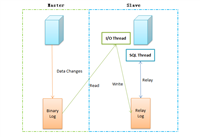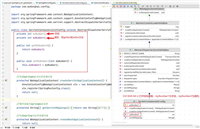1. 请解释mysql中的case语句和if语句的区别。
mysql中的case语句和if语句都可以用于条件判断,但它们的使用方式和语法有所不同。
- case语句:case语句是一种更灵活的条件判断结构,它可以处理多个条件和结果。case语句的基本语法如下:
case expression
when value1 then result1
when value2 then result2
...
else resultn
end;
其中,expression是要进行比较的值,value1、value2等是可能的取值,result1、result2等是对应的结果。当expression等于某个value时,返回对应的result。如果没有匹配的value,则返回else子句中的结果(如果有的话)。
举例:
select name, age, score,
case
when score >= 90 then '优秀'
when score >= 80 then '良好'
when score >= 60 then '及格'
else '不及格'
end as grade
from students;
- if语句:if语句是一种简单的条件判断结构,它只能处理两个条件(真或假)。if语句的基本语法如下:
if condition then result;
其中,condition是要进行比较的条件,result是条件为真时返回的结果。如果条件为真,则执行then子句中的结果;否则,什么都不做。if语句不能嵌套使用。
举例:
select name, age, score,
if(score >= 90, '优秀', if(score >= 80, '良好', if(score >= 60, '及格', '不及格'))) as grade
from students;
总结:case语句可以处理多个条件和结果,而if语句只能处理两个条件。在需要处理多个条件的情况下,应使用case语句。
2. 在mysql中,如何使用case语句实现条件查询?
在mysql中,可以使用case语句实现条件查询。case语句允许你在查询结果中根据某个条件返回不同的值。它的基本语法如下:
select column_name(s)
from table_name
case
when condition1 then result1
when condition2 then result2
...
else result
end;
举例说明:假设我们有一个名为employees的表,其中包含id、name和salary列。我们可以使用case语句来查询员工的姓名和薪水等级(低、中、高):
select id, name, salary,
case
when salary < 5000 then 'low'
when salary >= 5000 and salary < 10000 then 'medium'
else 'high'
end as salary_level
from employees;
这将返回一个结果集,其中包含每个员工的id、name、salary和salary_level(根据薪水分配的等级)。
3. 请举例说明如何在mysql中使用case语句进行数据转换。
在mysql中,可以使用case语句进行数据转换。以下是一个示例:
假设我们有一个名为employees的表,其中包含id、name和salary列。我们想要将员工的薪水等级(低、中、高)转换为大写字母。我们可以使用case语句来实现这个需求:
select id, name, salary,
case
when salary < 5000 then '低'
when salary >= 5000 and salary < 10000 then '中'
else '高'
end as salary_level
from employees;
这将返回一个结果集,其中包含每个员工的id、name、salary和salary_level(根据薪水分配的等级)。在这个例子中,我们将薪水等级从小写字母转换为大写字母。
4. 在mysql中,如何使用decode函数实现条件查询?
在mysql中,可以使用decode函数实现条件查询。以下是一个示例:
假设我们有一个名为employees的表,其中包含id、name和salary列。我们想要根据员工的薪水等级(低、中、高)查询员工的信息。我们可以使用decode函数来实现这个需求:
select id, name, salary,
decode(
case
when salary < 5000 then '低'
when salary >= 5000 and salary < 10000 then '中'
else '高'
end,
'低', '员工薪水较低',
'中', '员工薪水适中',
'高', '员工薪水较高'
) as salary_level
from employees;
这将返回一个结果集,其中包含每个员工的id、name、salary和salary_level(根据薪水分配的等级)。在这个例子中,我们使用了decode函数将薪水等级从小写字母转换为中文描述。
5. 请举例说明如何在mysql中使用decode函数进行数据转换。
在mysql中,可以使用decode()函数进行数据转换。decode()函数接受三个参数:第一个参数是要检查的条件,第二个参数是条件为真时返回的值,第三个参数是条件为假时返回的值。
以下是一个使用decode()函数的示例:
假设我们有一个名为employees的表,其中包含id、name和salary列。我们想要根据员工的薪水等级(低、中、高)查询员工的信息。我们可以使用decode()函数来实现这个需求:
select id, name, salary,
decode(
case
when salary < 5000 then '低'
when salary >= 5000 and salary < 10000 then '中'
else '高'
end,
'低', '员工薪水较低',
'中', '员工薪水适中',
'高', '员工薪水较高'
) as salary_level
from employees;
在这个例子中,我们首先使用case语句判断员工的薪水等级,然后使用decode()函数将薪水等级转换为中文描述。最后,我们将结果作为salary_level列返回。
6. 在mysql中,如何使用switch语句实现条件查询?
在mysql中,没有直接使用switch语句的语法。但是,可以使用case语句来实现类似的功能。以下是一个使用case语句实现条件查询的示例:
假设我们有一个名为employees的表,其中包含id、name和salary列。我们想要根据员工的薪水等级(低、中、高)查询员工的信息。我们可以使用case语句来实现这个需求:
select id, name, salary,
case
when salary < 5000 then '低'
when salary >= 5000 and salary < 10000 then '中'
else '高'
end as salary_level
from employees;
在这个例子中,我们首先使用case语句判断员工的薪水等级,然后使用case语句将薪水等级转换为中文描述。最后,我们将结果作为salary_level列返回。
7. 请举例说明如何在mysql中使用switch语句进行数据转换。
在mysql中,没有直接使用switch语句的语法。但是,可以使用case语句来实现类似的功能。以下是一个使用case语句实现条件查询的示例:
假设我们有一个名为employees的表,其中包含id、name和salary列。我们想要根据员工的薪水等级(低、中、高)查询员工的信息。我们可以使用case语句来实现这个需求:
select id, name, salary,
case
when salary < 5000 then '低'
when salary >= 5000 and salary < 10000 then '中'
else '高'
end as salary_level
from employees;
在这个例子中,我们首先使用case语句判断员工的薪水等级,然后使用case语句将薪水等级转换为中文描述。最后,我们将结果作为salary_level列返回。
8. 在mysql中,如何使用case语句、if语句、decode函数和switch语句实现复杂的条件查询和数据转换?
在mysql中,可以使用case语句、if语句、decode函数和switch语句来实现复杂的条件查询和数据转换。以下是一些示例:
- 使用case语句实现条件查询:
select id, name, salary,
case
when salary < 5000 then '低'
when salary >= 5000 and salary < 10000 then '中'
else '高'
end as salary_level
from employees;
- 使用if语句实现条件查询:
select id, name, salary,
if(salary < 5000, '低', if(salary >= 5000 and salary < 10000, '中', '高')) as salary_level
from employees;
- 使用decode函数实现条件查询:
select id, name, salary,
decode(salary, 0, '零', 1, '一', 2, '二', 3, '三', 4, '四', 5, '五', 6, '六', 7, '七', 8, '八', 9, '九') as salary_str
from employees;
- 使用switch语句实现条件查询(仅适用于mysql 8.0及更高版本):
select id, name, salary,
case
when salary < 5000 then '低'
when salary >= 5000 and salary < 10000 then '中'
else '高'
end as salary_level
from employees
where salary in (
select salary from employees order by salary limit 1 offset floor((count(*) - 1) / 3)
);
这些示例展示了如何在mysql中使用case语句、if语句、decode函数和switch语句实现复杂的条件查询和数据转换。
9. 请解释mysql中的null值在case语句、if语句、decode函数和switch语句中的行为。
在mysql中,null值在case语句、if语句、decode函数和switch语句中的行为如下:
- case语句:当case表达式的值为null时,mysql会返回null作为结果。例如:
select id, name, salary,
case
when salary < 5000 then '低'
when salary >= 5000 and salary < 10000 then '中'
else '高'
end as salary_level
from employees;
在这个例子中,如果某个员工的薪水为null,那么salary_level列将显示为null。
- if语句:当if条件为null时,mysql会返回null作为结果。例如:
select id, name, salary,
if(salary < 5000, '低', if(salary >= 5000 and salary < 10000, '中', '高')) as salary_level
from employees;
在这个例子中,如果某个员工的薪水为null,那么salary_level列将显示为null。
- decode函数:当decode函数的条件为null时,mysql会返回null作为结果。例如:
select id, name, salary,
decode(salary, 0, '零', 1, '一', 2, '二', 3, '三', 4, '四', 5, '五', 6, '六', 7, '七', 8, '八', 9, '九') as salary_str
from employees;
在这个例子中,如果某个员工的薪水为null,那么salary_str列将显示为null。
- switch语句(仅适用于mysql 8.0及更高版本):当switch表达式的值为null时,mysql会返回null作为结果。例如:
select id, name, salary,
case
when salary < 5000 then '低'
when salary >= 5000 and salary < 10000 then '中'
else '高'
end as salary_level
from employees
where salary in (
select salary from employees order by salary limit 1 offset floor((count(*) - 1) / 3)
);
在这个例子中,如果某个员工的薪水为null,那么salary_level列将显示为null。
10. 在mysql中,如何优化使用case语句、if语句、decode函数和switch语句的查询性能?
在mysql中,优化使用case语句、if语句、decode函数和switch语句的查询性能主要可以从以下几个方面进行:
避免使用null值:尽量避免在查询中使用null值,因为mysql需要对null值进行特殊处理。如果可能,尽量使用具体的值替换null。
使用索引:为查询中的列创建索引可以提高查询性能。特别是当使用case语句、if语句、decode函数或switch语句时,为这些列创建索引可以显著提高查询速度。
减少计算量:尽量减少在查询中使用的计算量,例如,避免在查询中使用复杂的表达式或函数。
使用explain分析查询:使用explain关键字可以查看mysql如何执行查询,从而了解查询的性能瓶颈在哪里。
使用limit子句:如果只需要查询结果的一部分,可以使用limit子句来限制返回的结果数量,从而提高查询性能。
使用join代替子查询:如果可能,使用join代替子查询可以提高查询性能。
使用存储过程:如果查询非常复杂,可以考虑将查询分解为多个简单的存储过程,然后通过调用这些存储过程来执行查询。
使用视图:如果查询涉及到大量的数据,可以考虑使用视图来存储查询结果,这样可以减少数据库的负载。
使用缓存:如果查询的结果不经常变化,可以考虑使用缓存来存储查询结果,这样可以减少数据库的访问次数。
使用并行查询:如果数据库支持并行查询,可以考虑使用并行查询来提高查询性能。
(在mysql中,优化使用case语句、if语句、decode函数和switch语句的查询性能主要取决于以下几个因素:避免使用null值作为条件:null值可能会导致查询性能下降,因为它需要额外的处理。如果可能,尽量避免在查询中使用null值。
使用索引:如果你的条件是基于列的值,那么使用索引可以大大提高查询性能。例如,如果你有一个名为
users的表,其中有一个名为age的列,你可以创建一个索引来加速基于age的查询。减少嵌套:嵌套的case语句、if语句、decode函数和switch语句可能会导致查询性能下降。尽量将它们简化为单个语句。
使用explain关键字:explain关键字可以帮助你了解mysql如何执行查询,以及哪些部分可能需要优化。
以下是一些示例代码:
-- 使用case语句
select name, age,
case
when age < 18 then '未成年'
when age >= 18 and age < 65 then '成年'
else '老年'
end as age_group
from users;
-- 使用if语句
select name, age,
if(age < 18, '未成年', if(age >= 18 and age < 65, '成年', '老年')) as age_group
from users;
-- 使用decode函数
select name, age,
decode(age, 0, '未知',
case
when age < 18 then '未成年'
when age >= 18 and age < 65 then '成年'
else '老年'
end) as age_group
from users;
-- 使用switch语句(仅适用于mysql 8.0及更高版本)
select name, age,
case
when age = 0 then '未知'
when age < 18 then '未成年'
when age >= 18 and age < 65 then '成年'
else '老年'
end as age_group
from users;
以上代码都是根据年龄分组用户,但是使用了不同的方法来实现。每种方法都有其优点和缺点,你需要根据你的具体需求和数据库系统的特性来选择最适合的方法。)
11.请解释mysql中的case表达式的优先级规则。
mysql中的case表达式的优先级规则如下:
- case表达式的优先级高于其他运算符,如比较运算符(=、<>、<、>等)和逻辑运算符(and、or等)。
- 在case表达式中,可以使用多个when子句来定义不同的条件。当满足某个条件时,将返回对应的结果。如果没有满足任何条件,则返回else子句中的结果(如果有的话)。
- 如果case表达式中有嵌套的case表达式,那么内部的case表达式会先于外部的case表达式进行计算。
- 在case表达式中,可以使用order by子句对结果进行排序。如果省略order by子句,则结果的顺序是不确定的。
- 在case表达式中,可以使用limit子句限制返回的结果数量。如果省略limit子句,则返回所有满足条件的结果。
- 在case表达式中,可以使用null值作为条件。如果条件为null,则返回else子句中的结果(如果有的话)。
- 在case表达式中,可以使用函数作为条件或结果。函数的优先级与case表达式中的其他运算符相同。
- 在case表达式中,可以使用算术运算符(+、-、*、/等)和字符串连接运算符(||)作为结果。算术运算符的优先级高于字符串连接运算符。
以下是一些mysql的循环语句相关的高级面试题:
12. 请解释mysql中的循环控制结构,比如while、loop和iterate?
mysql中的循环控制结构主要有while、loop和iterate。
- while循环:while循环用于在满足某个条件时重复执行一段代码。语法如下:
while condition do
-- 循环体,需要重复执行的代码
end while;
例如,下面的代码将打印数字1到5:
delimiter //
create procedure print_numbers()
begin
declare i int default 1;
while i <= 5 do
select i;
set i = i + 1;
end while;
end //
delimiter ;
call print_numbers();
- loop循环:loop循环与while循环类似,但它没有条件表达式。当进入循环时,它会一直执行循环体,直到遇到break语句或程序结束。语法如下:
loop
-- 循环体,需要重复执行的代码
if some_condition then
leave loop;
end if;
end loop;
例如,下面的代码将打印数字1到5:
delimiter //
create procedure print_numbers()
begin
declare i int default 1;
loop
select i;
set i = i + 1;
if i > 5 then
leave loop;
end if;
end loop;
end //
delimiter ;
call print_numbers();
- iterate循环:iterate循环用于遍历存储过程的结果集。它通常与游标一起使用。语法如下:
declare cur cursor for select * from some_table;
declare continue handler for not found set done = 1;
open cur;
my_loop: loop
fetch cur into @some_variable;
if done then
leave my_loop;
end if;
-- 处理每一行数据的逻辑
end loop;
close cur;
例如,下面的代码将打印users表中的所有用户名:
delimiter //
create procedure print_usernames()
begin
declare cur cursor for select username from users;
declare continue handler for not found set done = 1;
open cur;
my_loop: loop
fetch cur into @username;
if done then
leave my_loop;
end if;
select @username;
end loop;
close cur;
end //
delimiter ;
call print_usernames();
13. 如何在mysql中使用循环控制结构实现复杂的数据操作?
在mysql中,可以使用循环控制结构(如while、loop和iterate)来实现复杂的数据操作。以下是一些示例:
- 使用while循环插入多条数据:
delimiter $$
create procedure insert_data()
begin
declare i int default 0;
while i < 10 do
insert into table_name (column1, column2) values (value1, value2);
set i = i + 1;
end while;
end$$
delimiter ;
call insert_data();
- 使用loop循环更新多条数据:
delimiter $$
create procedure update_data()
begin
declare done int default false;
declare id int;
declare cur cursor for select id from table_name;
declare continue handler for not found set done = true;
open cur;
read_loop: loop
fetch cur into id;
if done then
leave read_loop;
end if;
update table_name set column1 = value1 where id = id;
end loop;
close cur;
end$$
delimiter ;
call update_data();
- 使用iterate跳过当前迭代并进入下一次迭代:
delimiter $$
create procedure skip_data()
begin
declare i int default 0;
while i < 10 do
if condition then
iterate; -- 如果满足某个条件,跳过当前迭代并进入下一次迭代
else
-- 执行其他操作
end if;
set i = i + 1;
end while;
end$$
delimiter ;
call skip_data();
这些示例展示了如何在mysql中使用循环控制结构实现复杂的数据操作。根据实际需求,可以组合使用这些结构来处理更复杂的逻辑。
14. 在mysql中,如何使用循环控制结构进行数据的批量更新?
在mysql中,可以使用存储过程和循环控制结构进行数据的批量更新。以下是一个示例,该示例展示了如何使用存储过程和循环来批量更新表中的数据:
- 首先,创建一个名为
update_data_batch的存储过程,该过程接受两个参数:start_id和end_id。这个存储过程将遍历从start_id到end_id的所有id,并将每个id对应的value字段的值增加1。
delimiter //
create procedure update_data_batch(in start_id int, in end_id int)
begin
declare i int default start_id;
while i <= end_id do
update your_table
set value = value + 1
where id = i;
set i = i + 1;
end while;
end //
delimiter ;
- 然后,调用
update_data_batch存储过程,传入你想要开始和结束的id。
call update_data_batch(1, 100);
这将批量更新表your_table中id为1到100的所有记录,将它们的value字段的值增加1。
请注意,你需要将上述代码中的your_table替换为你实际要操作的表名。
15. 请举例说明如何在mysql中使用循环控制结构进行条件查询?
在mysql中,可以使用存储过程和循环控制结构进行条件查询。以下是一个示例,该示例展示了如何使用存储过程和循环来根据多个条件进行查询:
- 首先,创建一个名为
query_data_by_conditions的存储过程,该过程接受两个参数:start_id和end_id。这个存储过程将遍历从start_id到end_id的所有id,并根据每个id对应的value字段的值是否大于50进行查询。
delimiter //
create procedure query_data_by_conditions(in start_id int, in end_id int)
begin
declare i int default start_id;
while i <= end_id do
select * from your_table
where id = i and value > 50;
set i = i + 1;
end while;
end //
delimiter ;
- 然后,调用
query_data_by_conditions存储过程,传入你想要开始和结束的id。
call query_data_by_conditions(1, 100);
这将批量查询表your_table中id为1到100的所有记录,并返回那些value字段的值大于50的记录。
请注意,你需要将上述代码中的your_table替换为你实际要操作的表名。
16. 在mysql中,如何使用循环控制结构处理子查询?特别是当子查询的表大的时候,如何优化查询性能?
在mysql中,可以使用循环控制结构处理子查询。当子查询的表大的时候,可以通过以下几种方式优化查询性能:
使用索引:确保子查询中的列都有索引,这样mysql可以更快地找到匹配的行。
使用limit:如果子查询的结果集很大,可以使用limit子句来限制返回的行数。
使用join代替子查询:如果可能,尽量使用join代替子查询,因为join通常比子查询更高效。
使用exists或in:如果只需要检查是否存在满足条件的行,而不是获取所有满足条件的行,可以使用exists或in。
使用临时表:如果需要多次执行相同的子查询,可以将结果存储在一个临时表中,然后在主查询中引用这个临时表。
以下是一个使用循环控制结构处理子查询的例子:
create procedure process_subquery()
begin
declare done int default false;
declare id int;
declare cur cursor for select id from your_table;
declare continue handler for not found set done = true;
open cur;
read_loop: loop
fetch cur into id;
if done then
leave read_loop;
end if;
select * from your_subquery_table where id = id;
end loop;
close cur;
end;
在这个例子中,我们首先声明了一个游标cur,用于遍历your_table表中的所有id。然后,我们在一个循环中读取每个id,并从your_subquery_table表中选择与该id匹配的行。当没有更多的行时,循环将结束。
17. 请解释mysql中的游标是什么以及如何使用游标处理结果集?
mysql中的游标是一个数据库查询结果集的抽象概念,它允许你遍历和操作结果集中的每一行。游标通常与存储过程、函数或脚本一起使用,以便在处理大量数据时逐行处理结果集。
使用游标处理结果集的基本步骤如下:
- 声明游标:使用declare语句声明一个游标,指定其类型(如cursor for、cursor local等)和select语句作为其源。
declare cur cursor for select id, name from your_table;
- 打开游标:使用open语句打开游标,使其准备好从源查询中获取数据。
open cur;
- 获取数据:使用fetch语句从游标中获取一行数据,并将其存储在变量中。可以指定要获取的列(如fetch next),或者获取所有列(如fetch all)。
fetch cur into @id, @name;
处理数据:对获取到的数据进行处理,例如更新表、插入新记录等。
关闭游标:使用close语句关闭游标,释放与其相关的资源。
close cur;
- 如果需要再次遍历结果集,可以重新打开游标并重复步骤3-5。否则,可以使用deallocate语句释放游标占用的资源。
deallocate cur;
以下是一个使用游标处理结果集的完整示例:
delimiter //
create procedure process_data()
begin
declare done int default false;
declare id int;
declare name varchar(255);
declare cur cursor for select id, name from your_table;
declare continue handler for not found set done = true;
open cur;
read_loop: loop
fetch cur into id, name;
if done then
leave read_loop;
end if;
-- 在这里处理数据,例如更新表、插入新记录等
update another_table set status = 'processed' where id = id;
insert into log_table (id, action) values (id, 'processed');
end loop;
close cur;
end //
delimiter ;
18. 在mysql中,如何使用循环控制结构和游标处理嵌套查询的结果集?
在mysql中,可以使用循环控制结构和游标处理嵌套查询的结果集。以下是一个示例:
假设我们有两个表,一个是员工表(employees),另一个是部门表(departments)。我们想要查询每个部门的员工数量。
首先,我们需要创建一个存储过程来执行这个查询。在这个存储过程中,我们将使用一个外部游标来遍历部门表,然后使用一个内部游标来遍历员工表。
delimiter $$
create procedure getemployeecountperdepartment()
begin
-- 声明外部游标
declare done int default false;
declare cur_dept int;
declare continue handler for not found set done = true;
-- 声明内部游标
declare cur_emp cursor for
select department_id from employees;
declare continue handler for not found set done = true;
-- 打开外部游标
open cur_dept;
read_loop: loop
-- 获取外部游标的数据
fetch cur_dept into cur_dept;
if done then
leave read_loop;
end if;
-- 初始化内部游标的计数器
set @employee_count = 0;
-- 打开内部游标
open cur_emp;
inner_loop: loop
-- 获取内部游标的数据
fetch cur_emp into @cur_dept;
if done then
leave inner_loop;
end if;
-- 如果员工属于当前部门,增加计数器
if @cur_dept = cur_dept then
set @employee_count = @employee_count + 1;
end if;
end loop inner_loop;
-- 关闭内部游标
close cur_emp;
-- 输出结果
select cur_dept, @employee_count as employee_count;
end loop read_loop;
-- 关闭外部游标
close cur_dept;
end$$
delimiter ;
现在,我们可以调用这个存储过程来获取每个部门的员工数量:
call getemployeecountperdepartment();
19. 请解释mysql中的存储过程和函数的区别以及它们在循环语句中的应用。
存储过程和函数在mysql中都是用于执行特定任务的预编译sql代码块。它们之间的主要区别在于它们的用途和返回值。
存储过程:存储过程是一种预编译的sql代码块,它可以包含输入参数、输出参数和返回值。存储过程可以多次调用,而函数只能被调用一次。存储过程通常用于执行复杂的逻辑和操作,例如数据处理、数据转换等。
函数:函数是一种预编译的sql代码块,它没有输入参数和输出参数,但可以有返回值。函数通常用于执行简单的逻辑和操作,例如计算、条件判断等。
在循环语句中的应用:
- 存储过程:在循环语句中调用存储过程时,可以使用游标或循环结构来遍历数据集并执行存储过程。例如,可以使用游标遍历表中的每一行,并为每一行调用存储过程。
delimiter //
create procedure process_rows()
begin
declare cur cursor for select * from my_table;
declare continue handler for not found set done = true;
declare @id int;
open cur;
read_loop: loop
fetch cur into @id;
if done then
leave read_loop;
end if;
-- 调用存储过程处理每一行
call my_stored_procedure(@id);
end loop;
close cur;
end //
delimiter ;
- 函数:在循环语句中调用函数时,可以直接使用循环结构遍历数据集并执行函数。例如,可以使用循环遍历表中的每一行,并为每一行调用函数。
delimiter //
create procedure process_rows()
begin
declare done int default false;
declare cur cursor for select * from my_table;
declare continue handler for not found set done = true;
declare @id int;
open cur;
read_loop: loop
fetch cur into @id;
if done then
leave read_loop;
end if;
-- 调用函数处理每一行
select my_function(@id);
end loop;
close cur;
end //
delimiter ;
20. 在mysql中,如何使用循环控制结构和存储过程或函数实现更高效的数据处理?
在mysql中,我们可以使用循环控制结构(如while循环或for循环)和存储过程或函数来实现更高效的数据处理。
- 使用while循环:while循环是一种基本的循环结构,它会一直执行,直到指定的条件不再满足。以下是一个示例,该示例将查询数据库中的所有记录,并将每条记录的id打印出来。
delimiter $$
create procedure printids()
begin
declare done int default false;
declare id int;
declare cur cursor for select id from table_name;
declare continue handler for not found set done = true;
open cur;
read_loop: loop
fetch cur into id;
if done then
leave read_loop;
end if;
select id;
end loop;
close cur;
end$$
delimiter ;
- 使用for循环:for循环是另一种基本的循环结构,它允许你指定一个范围,并在该范围内重复执行一段代码。以下是一个示例,该示例将查询数据库中的所有记录,并将每条记录的id打印出来。
delimiter $$
create procedure printids()
begin
declare done int default false;
declare id int;
declare cur cursor for select id from table_name;
declare continue handler for not found set done = true;
open cur;
read_loop: loop
fetch cur into id;
if done then
leave read_loop;
end if;
select id;
end loop;
close cur;
end$$
delimiter ;
- 使用存储过程或函数:存储过程和函数都可以用于实现更高效的数据处理。存储过程和函数可以包含复杂的逻辑和数据处理操作,而不仅仅是简单的sql查询。以下是一个示例,该示例将查询数据库中的所有记录,并将每条记录的id打印出来。
delimiter $$
create procedure printids()
begin
declare cur cursor for select id from table_name;
declare id int;
open cur;
read_loop: loop
fetch cur into id;
if done then
leave read_loop;
end if;
select id;
end loop;
close cur;
end$$
delimiter ;
21. 对于大量数据的处理,如何利用循环控制结构来提升mysql的查询性能?
对于大量数据的处理,我们可以使用循环控制结构来提升mysql的查询性能。以下是一个示例:
假设我们有一个名为students的表,其中包含学生的姓名和年龄信息。我们想要查询所有年龄大于18岁的学生的信息。
首先,我们需要创建一个存储过程来实现这个功能:
delimiter $$
create procedure getadultstudents()
begin
declare done int default false;
declare cur cursor for select * from students where age > 18;
declare continue handler for not found set done = true;
open cur;
read_loop: loop
fetch cur into @name, @age;
if done then
leave read_loop;
end if;
-- 在这里处理每个学生的信息,例如打印出来
select @name, @age;
end loop;
close cur;
end$$
delimiter ;
然后,我们可以调用这个存储过程来获取所有年龄大于18岁的学生的信息:
call getadultstudents();
通过使用循环控制结构(如loop和continue),我们可以在每次迭代中只处理一个学生的信息,从而减少内存占用和提高查询性能。
总结
到此这篇关于mysql中switch语句和循环语句的文章就介绍到这了,更多相关mysql switch语句和循环语句内容请搜索代码网以前的文章或继续浏览下面的相关文章希望大家以后多多支持代码网!







发表评论